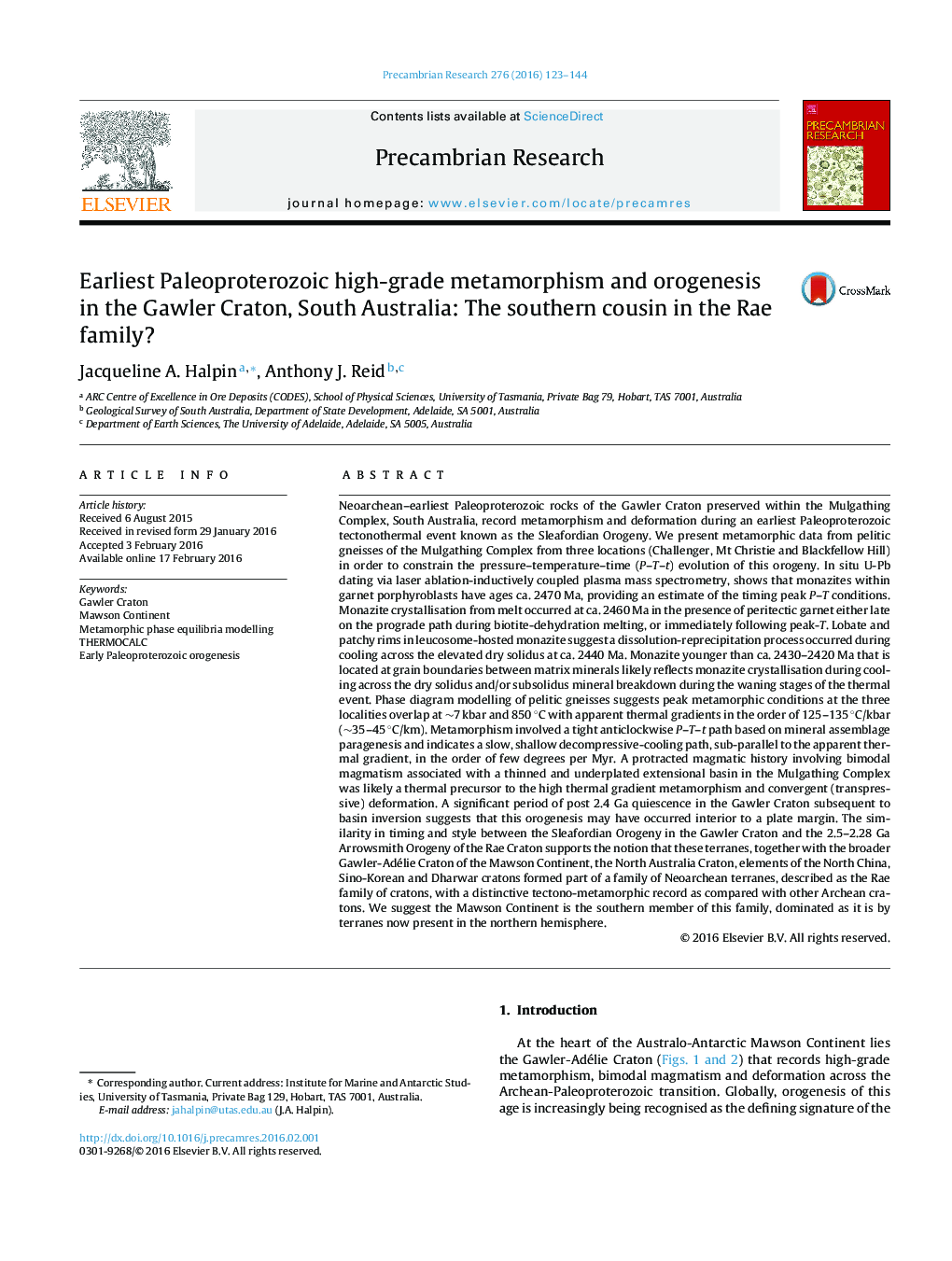| Article ID | Journal | Published Year | Pages | File Type |
|---|---|---|---|---|
| 4722402 | Precambrian Research | 2016 | 22 Pages |
•Mulgathing Complex, Gawler Craton, records high-grade c. 2.47–2.4 Ga metamorphism.•In situ U-Pb monazite and P–T modelling constrain a tight anti-clockwise P–T–t path.•Peak conditions reached ∼7 kbar and ∼850 °C, with slow decompressive-cooling.•Inversion of a thinned/underplated extensional basin is a plausible tectonic setting.•May have sat internal to an amalgamating ‘Rae family’ supercraton.
Neoarchean–earliest Paleoproterozoic rocks of the Gawler Craton preserved within the Mulgathing Complex, South Australia, record metamorphism and deformation during an earliest Paleoproterozoic tectonothermal event known as the Sleafordian Orogeny. We present metamorphic data from pelitic gneisses of the Mulgathing Complex from three locations (Challenger, Mt Christie and Blackfellow Hill) in order to constrain the pressure–temperature–time (P–T–t) evolution of this orogeny. In situ U-Pb dating via laser ablation-inductively coupled plasma mass spectrometry, shows that monazites within garnet porphyroblasts have ages ca. 2470 Ma, providing an estimate of the timing peak P–T conditions. Monazite crystallisation from melt occurred at ca. 2460 Ma in the presence of peritectic garnet either late on the prograde path during biotite-dehydration melting, or immediately following peak-T. Lobate and patchy rims in leucosome-hosted monazite suggest a dissolution-reprecipitation process occurred during cooling across the elevated dry solidus at ca. 2440 Ma. Monazite younger than ca. 2430–2420 Ma that is located at grain boundaries between matrix minerals likely reflects monazite crystallisation during cooling across the dry solidus and/or subsolidus mineral breakdown during the waning stages of the thermal event. Phase diagram modelling of pelitic gneisses suggests peak metamorphic conditions at the three localities overlap at ∼7 kbar and 850 °C with apparent thermal gradients in the order of 125–135 °C/kbar (∼35–45 °C/km). Metamorphism involved a tight anticlockwise P–T–t path based on mineral assemblage paragenesis and indicates a slow, shallow decompressive-cooling path, sub-parallel to the apparent thermal gradient, in the order of few degrees per Myr. A protracted magmatic history involving bimodal magmatism associated with a thinned and underplated extensional basin in the Mulgathing Complex was likely a thermal precursor to the high thermal gradient metamorphism and convergent (transpressive) deformation. A significant period of post 2.4 Ga quiescence in the Gawler Craton subsequent to basin inversion suggests that this orogenesis may have occurred interior to a plate margin. The similarity in timing and style between the Sleafordian Orogeny in the Gawler Craton and the 2.5–2.28 Ga Arrowsmith Orogeny of the Rae Craton supports the notion that these terranes, together with the broader Gawler-Adélie Craton of the Mawson Continent, the North Australia Craton, elements of the North China, Sino-Korean and Dharwar cratons formed part of a family of Neoarchean terranes, described as the Rae family of cratons, with a distinctive tectono-metamorphic record as compared with other Archean cratons. We suggest the Mawson Continent is the southern member of this family, dominated as it is by terranes now present in the northern hemisphere.
